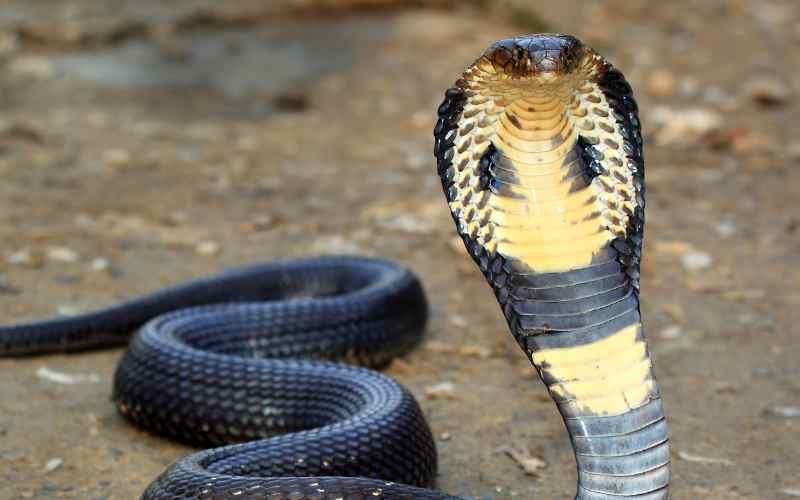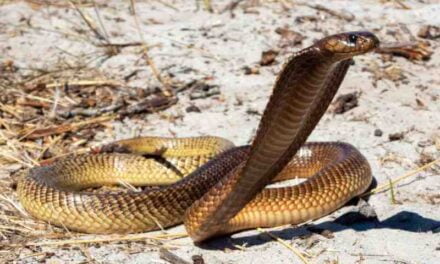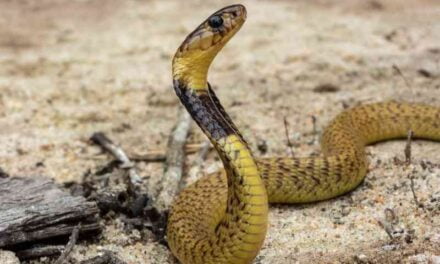The Egyptian Cobra, scientifically known as Naja haje, is a fascinating and enigmatic snake species that has captured the imagination of people for centuries. This iconic serpent is not only known for its striking appearance but also its historical and cultural significance, making it an intriguing subject for exploration. In this blog, we will delve into the world of Naja haje, learning about its physical characteristics, habitat, behavior, and its rich cultural ties.
Physical Characteristics:
One of the most distinctive features of the Egyptian Cobra is its striking appearance. These snakes are typically medium-sized, with adults averaging around 1.5 to 2 meters (5 to 6.5 feet) in length. Their slender bodies are covered in smooth, glossy scales that can range in color from pale yellow to a rich brown or even black. However, what truly sets them apart are the bold and distinctive markings on their hoods, which form an intricate pattern resembling an eye or a pair of spectacles. This marking is not just for aesthetics but serves a crucial role in the snake’s survival.
Habitat and Distribution:
The Egyptian Cobra is native to a wide range of habitats in North Africa and parts of the Middle East. Their distribution spans across countries such as Egypt, Sudan, Chad, Niger, and Israel, among others. They are highly adaptable and can be found in a variety of environments, including deserts, savannas, and cultivated fields. These snakes are often encountered near water sources as they are excellent swimmers.
Behavior and Diet:
Naja haje is a primarily nocturnal snake, meaning it is most active during the night. During the day, they can often be found sheltering in burrows, rock crevices, or abandoned termite mounds. When threatened or provoked, Egyptian Cobras will raise their hoods, revealing the distinctive eye-like markings, hiss loudly, and may strike if they feel cornered. However, they are not typically aggressive and will usually prefer to escape rather than confront a potential threat.
In terms of diet, Egyptian Cobras are carnivorous and primarily feed on small mammals, birds, amphibians, and occasionally other snakes. They are skilled hunters, using their excellent eyesight to locate prey in low-light conditions. Once they’ve spotted their quarry, they will strike swiftly and inject venom through their fangs. The venom contains a potent cocktail of toxins that immobilize or kill the prey, allowing the snake to consume it at its leisure.
Cultural Significance:
The Egyptian Cobra holds a special place in Egyptian culture and history. It was featured prominently in ancient Egyptian mythology and symbolism. The cobra was associated with the goddess Wadjet, who was often depicted as a cobra or as a woman wearing a cobra headdress. Wadjet was considered a protective deity and a symbol of lower Egypt. Her image was used to ward off evil and provide protection.
In addition to its mythical importance, the Egyptian Cobra had a practical role in ancient Egypt as well. These snakes were often kept in temples and homes to deter rodents, which were a common problem in grain stores. The presence of a cobra was seen as a safeguard against infestations, and the snakes were treated with great respect.
Conservation Status:
Like many snake species, the Egyptian Cobra faces threats to its survival. Habitat destruction, persecution by humans, and the illegal pet trade are some of the challenges these snakes encounter. Additionally, they often fall victim to road traffic accidents when they venture onto roads at night. Conservation efforts are underway to protect the habitat and raise awareness about the importance of these snakes in maintaining the ecological balance.
How do Egyptian cobras hunt?
Egyptian cobras are nocturnal hunters, meaning they are most active at night. They use their keen sense of smell to track down their prey, which consists mainly of toads, lizards, birds, and small mammals. Once they have located their prey, they will strike quickly and accurately, injecting their venom into the victim. The venom paralyzes the prey, making it easy for the cobra to swallow it whole.
How do Egyptian cobras defend themselves?
When threatened, Egyptian cobras will first try to escape. However, if they are cornered, they will assume a defensive posture by raising their upper body and expanding their hood. This makes them look larger and more intimidating to their predator. If the predator does not back down, the cobra will strike.
Egyptian cobras also have the ability to spit their venom, which is a rare behavior among snakes. They can spit their venom up to six feet away, and it can cause temporary blindness and irritation if it gets in the eyes.
How do Egyptian cobras interact with each other?
Egyptian cobras are solitary animals, meaning they do not live in groups. They only come together to mate. During courtship, the male will dance around the female and bob his head. If the female is receptive, she will allow the male to mate with her.
After mating, the female will lay a clutch of eggs in a burrow or other sheltered location. She will then incubate the eggs for several weeks until they hatch. Once the eggs hatch, the young cobras are on their own.
How do Egyptian cobras communicate?
Egyptian cobras communicate with each other using a variety of methods, including body language, scent marking, and hissing.
- Body language: Egyptian cobras use their body language to communicate their mood and intentions. For example, a cobra that is feeling threatened will raise its upper body and expand its hood. A cobra that is ready to strike will coil its body and flatten its head.
- Scent marking: Egyptian cobras use scent marking to mark their territory and to attract mates. They do this by rubbing their bodies on objects in their environment.
- Hissing: Egyptian cobras hiss to warn other snakes to stay away. They may also hiss if they are feeling threatened.
In addition to these methods, Egyptian cobras may also communicate with each other using vibrations in the ground.
In conclusion, the Egyptian Cobra, or Naja haje, is a remarkable snake species with a rich history and unique characteristics. Its stunning appearance, adaptability, and cultural significance make it a captivating subject of study and admiration. While these snakes may evoke fear in some, they play an essential role in their ecosystems, and efforts must be made to conserve their populations and protect their habitats for generations to come. By understanding and respecting these creatures, we can appreciate the intricate web of life in which they play a vital role.










The Egyptian Asp, known for its deadly venom, is a crucial part of North Africa’s ecosystem.